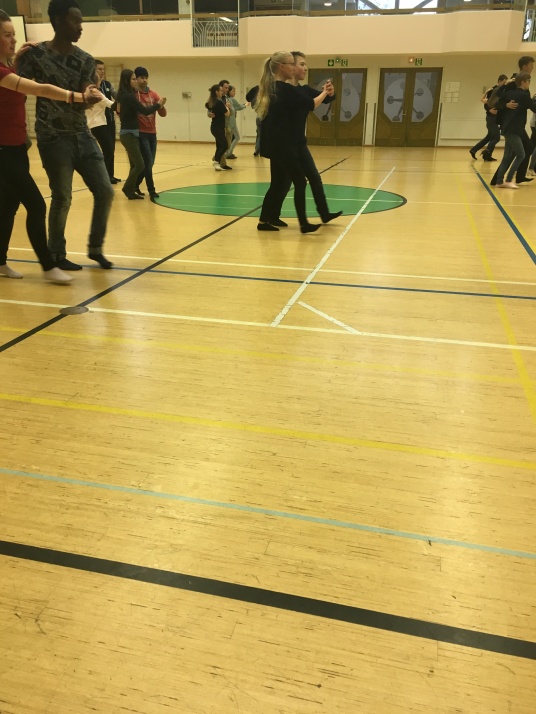I have been an 18-year old Finnish girl, a third-year, mere weeks to go until I depart for matriculation examinations, college entrance tests, and the great uncertainty of college acceptances. I have felt the slow anguish at the end of lunch as my level 9 Swedish lesson approached. I’ve giggled at the lunch tables drinking Pima and grumbled about the cold waiting for the bus to take me back to the city center. And I’ve argued, clearly and forcefully that the Fazer blue bar, and the 200 gram bar in particular, is the best Finnish candy has to offer.
It was, I guess, an interesting day.
It started as an observation, an academic visit to the Viikki Normal School (in Finnish, take a breath: Helsingin yliopston Viikin normaalikoulu). It was going to be anthropological and I would be removed, distant, apart. The goal was straightoward. I would take some notes, observe some classes, maybe record a few interviews, and then return to by research, with these valuable “field recordings” in hand.
That wasn’t what happened. Instead, it became a shadow day, a role play. I was no longer “David,” a 33-year old American teacher. I was now, like, Darja, just another average Finnish teenager.
And I learned that Finnish teenagers, while speaking a different language and eating different foods and having a different perspective of their place in the world, aren’t really that much different from their American counterparts in my high school and the many others like it. To distill it to “Kids are kids” is to do both countries’ youth a disservice, but there’s something common between the two.
My day in Viikki started with a ride to school. LIke I would at home, I got up close to 5:50 AM, but hitched a ride with the young woman who would be my guide and her father, a professor at the university I’m acquainted with, picked me up. It had snowed the day before, maybe two, and although I’d been awake that early and earlier before, the snow glowed that morning, lending the buildings and cars and people and trees an un-earthly underlit blue cast, which to this California boy is something strange.
When we arrived, I realized something I’d noticed at all the schools I’ve visited thus far. It’s not that the schools don’t look like such in the American sense, although they don’t. Finnish campuses blend with the environment, the neighborhood, the trees. They do not assert their place as so much of American architecture does. It’s also not that they seem smaller, student body-wise, compared to most American public schools – though they are: a thousand students is pretty standard from where I come from, yet half that is a decent-sized Finnish lukio. What I realized is that space may be chiefest among the Finnish virtues I’ve so far observed.
Each Finnish family with the means has a summer cabin, a little place further north – for us, that would be the lakeland in the middle of the country – that they cherish and speak only reverentially of. At tram or bus stops, Finns will give a meter or two between themselves and the next passenger. Even in their design, which the fair maiden has noted and recorded, the emphasis is not just on the object, but also on the space around it.
And in the schools, most of the space is not given over the offices or activities, to teacher work space or to storage. In fact, it seemed like any available space was public space – that is, student space. It was a literalization of the metaphor I’ve been using for years, that students are our customer and constituency, that services should be for them.
Like German classrooms, Finnish teachers travel from classroom to classroom and only share a common work space. The lounges and hallways are designed for student use, and there was very little formal oversight into how they were used.
The students were, in fact, just trusted, and they acted like it.
Then we danced. In advance of the day when the 3rd year (seniors) students leave the school, the 2nd year students practice formal and traditional danced for their prom. Note: Finnish prom is not like American prom. Because this school suffers from a lack of boys, I awkwardly stood in as a proxy second year, as did two of the senior girls whom I was shadowing.
Here’s a sample:

During lunch, we had yet another example of the fine Finnish school lunch. I know this will sound strange to my American followers, but the school lunch is good. I think it’s a key aspect of the educational democracy here. Everyone eats the food. Or they don’t eat. And it’s free, and healthy, and made of real food. Everyone eats the same food, they get the same education, the same opportunities, and it’s what they make of them that reveals their difference. There, I had a goulash, much more wonderful than its name and a dairy drink called pima that tastes like sour cream. I didn’t enjoy it. And, of course, some of that dark rye bread.
But of course man cannot live by bread alone, so we walked across the street to the Alepa and bought chocolate. At this time, I’d only had salmiakki, the famous salted licorice, and some Kinder products. But they swore up and down that Fazer, Fazer Blue, the Fazer Blue in the 200 gram bar was the best, the zenith of Finnish chocolate.
And you know what? It was.
The rest of the day was filled with classes and conversations. There, I had my first interviews with Finnish students, that I first began to find out what they see as the future of their country.








Enjoyed this day in the life piece, David. Great approach, wonderful insights. Looking forward to more of your work!
LikeLike